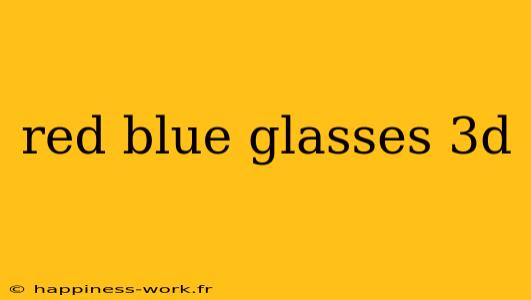Red and blue glasses, also known as anaglyph glasses, have been a staple in the realm of 3D visual experiences for decades. Originally developed for movies and animations, these glasses create an illusion of depth, enabling viewers to enjoy three-dimensional visuals right from the comfort of their own homes. But how do they work, and what makes them so unique? Let's delve deeper into the mechanics, applications, and the evolution of these intriguing tools.
How Do Red and Blue Glasses Work?
Red and blue glasses work based on the principle of stereoscopic vision, a process that allows our brains to perceive depth by combining two slightly different images viewed from two different angles (one for each eye). Here’s how they function:
- Dual Image Projection: When watching a 3D movie, two images are projected on the screen. One image is tinted red, while the other is tinted blue.
- Color Filtering: Each lens in the glasses allows only one color to pass through. The left lens is usually red, and the right lens is typically blue. This filtering helps each eye perceive only its corresponding image.
- Depth Perception: By sending a different image to each eye, our brain merges these images to create a perception of depth, resulting in the thrilling 3D effect.
Additional Explanation
While the basics of how red and blue glasses function are straightforward, understanding the science behind them reveals why some may find them less immersive compared to modern technologies. The main drawback lies in color distortion since the images are filtered. This led to the development of other 3D technologies, such as polarized 3D glasses used in multiplex theaters today.
Applications of Red and Blue 3D Glasses
Red and blue 3D glasses aren’t just a relic of the past. They continue to find utility in various fields. Here are a few notable applications:
- Home Movies and Gaming: Many vintage and indie 3D movies still utilize anaglyph techniques. Furthermore, some video games, especially those with a retro style, may incorporate this method for nostalgic effect.
- Education: In classrooms, educators can use red and blue glasses to enhance lessons in subjects like biology, physics, and geography, providing students with a more immersive learning experience.
- Art and Design: Artists may leverage this technology to present their work in a dynamic way, creating an interactive experience for viewers that encourages engagement with their art.
Practical Example
Consider a classroom scenario where students are learning about the human anatomy. By displaying a 3D diagram of the human body, complete with color-coded organs, students can wear red and blue glasses. This hands-on experience not only captures their attention but also aids in better retention of complex information.
Evolution of 3D Glasses
While red and blue glasses have a nostalgic charm, the technology has significantly advanced over the years. Today, we see polarized and active shutter glasses, which provide a more enhanced experience without color distortion.
- Polarized Glasses: Often used in modern theaters, these glasses work by filtering out certain light waves, allowing each eye to perceive two distinct images, creating a more natural color experience.
- Active Shutter Glasses: These require a compatible screen and synchronize with it to block each lens alternately, offering a clearer image with less ghosting.
Conclusion: The Legacy of Red and Blue Glasses
Red and blue 3D glasses hold a nostalgic yet functional place in the realm of visual experiences. Despite newer technologies emerging, they still serve an important role in specific contexts, reminding us of the roots of 3D vision. Whether it's for educational purposes or simply indulging in classic films, these glasses continue to enhance our appreciation for depth in visual media.
Additional Resources
For those looking to dive deeper into the mechanics of 3D technology and its applications, consider exploring:
- The Physics of 3D Movies - For a deeper understanding of the science behind stereoscopic vision.
- 3D Animation Techniques - To learn how to create your own 3D content, using modern tools alongside traditional methods like anaglyphs.
This article draws upon the foundational principles of 3D vision, utilizing information from WikiHow as part of its exploration into the topic of red and blue glasses.
